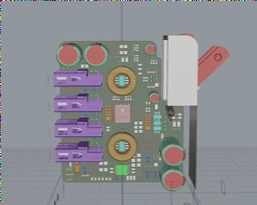In the structure of a flexible circuit board, the materials consist of the edge film, adhesive, and conductor.
**Edge Film**
The edge film serves as the foundational layer of the circuit, while the adhesive secures the copper foil to this edge layer. In multi-layer designs, it is subsequently bonded to the inner layer. Additionally, the edge film acts as a protective barrier, isolating the circuit from dust and moisture, and alleviating stress during flexing. The copper foil creates a conductive layer.
In certain FPCs, rigid components made from aluminum or stainless steel are employed, offering dimensional stability, physical support for component and wire placement, and stress relief. The adhesive unites the rigid component with the flexible circuit. Furthermore, another material sometimes utilized in flexible circuits is the adhesive layer, which is created by applying adhesive to both sides of the edge film. This adhesive layer provides environmental protection and maintains electronic integrity, potentially allowing for the elimination of a layer of film and enabling the bonding of multiple layers with fewer overall layers.

1. There are various types of film materials, but the most commonly utilized are polyimide and polyester. Currently, nearly 80% of flexible circuit manufacturers in the United States opt for polyimide film, while about 20% use polyester film. Polyimide is non-flammable, geometrically stable, possesses high tear strength, and can withstand high welding temperatures. Polyester, or polyethylene terephthalate (commonly referred to as PET), shares some physical properties with polyimide but has a lower dielectric constant and minimal moisture absorption, though it does not endure high temperatures well.
2. Polyesters have a melting point of 250°C and a glass transition temperature (Tg) of 80°C, which restricts their use in applications that involve significant end welding. In low-temperature scenarios, they exhibit rigidity. However, they are well-suited for products such as phones and other devices that aren’t subjected to extreme environments.
3. Polyimide edge film is typically paired with polyimide or acrylic adhesives, while polyester edge material generally uses polyester adhesives. The benefits of using materials with similar properties include enhanced dimensional stability post-dry welding and after multiple lamination cycles. Key attributes of the adhesives include a lower dielectric constant, higher end resistance, elevated glass transition temperature (Tg), and low moisture absorption.
4. In addition to bonding the edge film to the conductive material, the adhesive can also serve as a cover layer, protective coating, or encapsulating layer. The primary distinction between these functions lies in the application methods employed. The cover layer adheres to the edge film to create a laminated circuit, with screen printing technology often used for the adhesive covering and coating.
5. Not all laminate structures incorporate adhesives; those without adhesives yield thinner circuits and greater flexibility. Compared to adhesive-based laminated structures, they exhibit improved thermal conductivity. The thin profile of adhesive-free flexible printed circuits (FPC) eliminates the thermal resistance associated with adhesives, enhancing thermal conductivity and allowing use in environments unsuitable for adhesive-laminated flexible circuits.
6. Copper foil is well-suited for flexible circuits and can be either electrodeposited (ED) or plated. The surface of electrodeposited copper foil is glossy on one side, while the other side is matte and dull. This flexible material can be manufactured in various thicknesses and widths. The matte side of ED copper foil is often treated to enhance its bonding properties. Beyond flexibility, forged copper foil offers rigidity and smoothness, making it ideal for applications requiring dynamic deflection.
If you have any PCB manufacturing needs, please do not hesitate to contact me.Contact me



